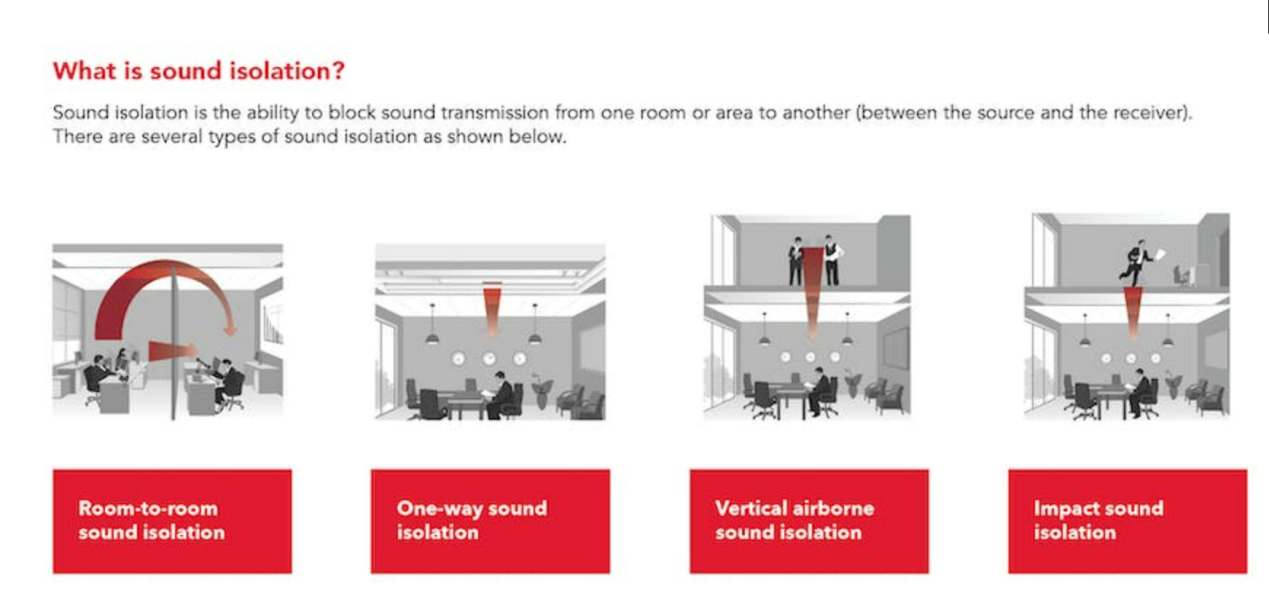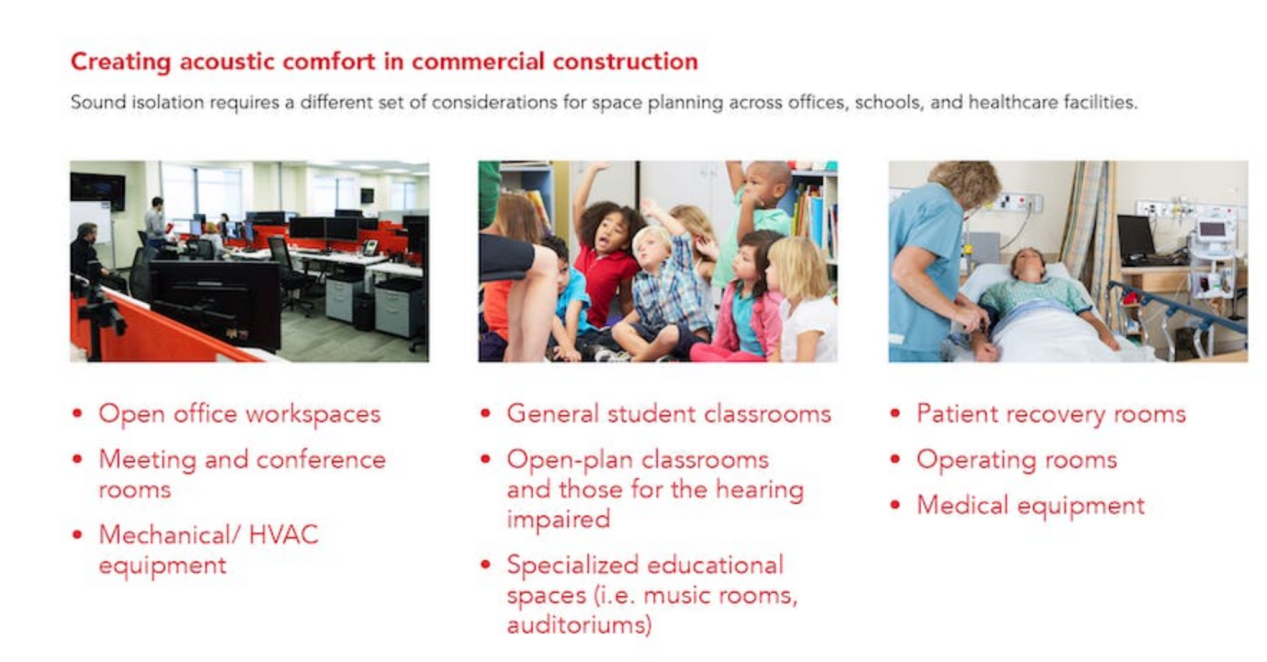Nov. 04, 2022
People spend 90% of their time in various types of indoor environments. Having a quiet and comfortable, healthy and environmentally friendly living room environment is very key to improving people's quality of life or improving work and learning efficiency. So soundproofing insulation materials is more and more popular in the market, and Huali rock wool innovate different types of sound insulation mineral wool type for clients.Many clients have no idea whether rock wool insulation is good for soundproofing or not, let’s learn today.
What is acoustic insulation?
Acoustic insulation is one aspect of soundproofing your space; it is typically a component of a floor or wall assembly designed to ensure sound comfort for occupants. Managing the acoustics of a built environment, by its most simple definition, is done by either blocking or absorbing sound (one example being a sound barrier wall with acoustic insulation inside).
Most acoustic home and building design plans include a combination of both to reduce the transmission of unwanted direct sound from the source. When it comes to blocking interior sound (we will also refer to this interchangeably as "sound isolation"), the materials selected to support the acoustics objectives matter as much as the design of the space itself.
What is sound isolation?
While"blocking"is the more commonly used term, sound isolation is the ability to block sound transmission from one room or area to another (between the source and the receiver). This may also be needed in instances where the room is upstairs or right next door.
Blocking (sound isolation) occurs when sound bounces off of hard, reflective materials in a space, whether on the ceiling, walls or partitions, windows, or the floor.
Absorption, conversely, is what happens when a material has the ability to absorb and dampen the sound. Softer materials, such as carpets, fabric panels or perforated ceiling tiles, are most often used for this purpose.
The design approach to be considered for sound isolation is separating (or decoupling) assembly materials to stop the transfer of sound energy. This soundproofing technique is often used in "floating" walls or floors but doesn’t have to be done by constructing a massive concrete slab or wall.
There are several types of sound isolation including room-to-room, one-way sound, vertical airborne sound, and impact sound.

Why should you consider acoustic insulation?
Acoustic insulation can be applied to almost any area to prevent noise from transmitting through the walls and floors - serving as somewhat of a sound barrier. As acoustic comfort in buildings becomes a greater priority for renovation, retrofit or new construction projects, acoustic insulation in walls, floors, and ceilings takes on greater importance in minimizing noise levels for occupants.
According to the National Institute of Building Sciences, providing a comfortable environment for employees contributes significantly to their optimum performance and reduced absenteeism. They also find that the factors contributing to worker productivity such as acoustic room design are still often overlooked.
That being said, there is a steadily increasing demand for acoustic comfort, driven by occupants and building professionals who recognize the importance it plays in our daily lives – at home, at work and in sensitive environments such as schools and hospitals. The other consideration is the increasing compliance required with building codes and voluntary guidelines surrounding acoustics which we examine in our article, ‘Defining the acoustic requirements and regulations for noise control in buildings’.
In residential applications, ensuring the right acoustic room design including sound-blocking walls is essential, especially if you’re looking for how to muffle sound through a shared wall. Acoustics planning is also an important component if you’re looking to convert your basement into a home theatre or music room where a sound barrier to the floor above may be needed. Acoustics room design can also help to minimize distractions in a home office or reduce the impact noise from noisy neighbors.
For commercial construction, you may want to consider the value of acoustic insulation to help in several areas, including:
·Office buildings: People working in offices – be they open-plan environments with cubicles, private rooms, or large meeting spaces – will likely encounter sound from mechanical equipment in adjacent spaces, copy machines and printers, and phones and voices from other people within the workplace. Creating office privacy and ensuring open plan office noise reduction will lead to a happier, healthier and more productive workforce,
·Healthcare facilities: Noise in many healthcare facilities is a 24/7 phenomenon; the source could be anything from loud equipment used in patient care, conversations between patients and care teams, visitors, making hospital acoustics and protecting patient confidentiality in a busy healthcare setting a valuable part of your design process, and
·Schools and educational institutions: Students and teachers alike will experience noise in the form of hallway foot traffic, conversations, other classrooms, mechanical equipment, and conversations inside the classroom. School acoustics are an important component of creating a positive and productive learning environment.
There are several different ways to achieve the sound isolation goals of a space. The construction assemblies used and the building materials that are specified and selected are only two examples. Sound blocking or isolation is a key component of any acoustics plan and there are numerous product options available to help you achieve the desired STC rating for your space including stone wool insulation.
In order to help you take the best approach for the project at hand, let’s first look at what sound isolation actually is and how it’s measured.

Regardless of the type of building and its unique needs and challenges, acoustics plays a critical role in supporting Indoor Environmental Quality (IEQ). IEQ is a fundamental principle in many voluntary certification programs, such as LEED, the FGI Guidelines Institute (FGI), and the WELL Building Standard. Acoustics is one of the components that will significantly affect occupant comfort and wellbeing.
It may surprise some to learn that sound travels easily through wood framing and the layer of drywall or sheetrock – usually the largest point of connection between you and your neighbors, whether in a home or commercial building. From the perspective of acoustics, it means planning properly with the right construction assemblies and insulation materials. While the best time to insulate and soundproof walls is during new construction, it is possible to add sound isolation to existing walls without tearing off the drywall.
With proper insulation and mass, walls can definitely help block out noise. But this still isn’t enough. In fact, closed offices often give the illusion of privacy. Even with appropriate insulation, noise will still find a way through other, less obvious, open spaces called flanking paths. For example, ceiling systems will always have noise leaks – created by installing light fixtures and HVAC ventilation air devices, among others – which make them even less effective at blocking or insulating sound. Since ceiling tiles are also usually poor at blocking sound because they don’t have sufficient mass, sound-absorbing tiles are a better option. Wall assemblies are also susceptible to flanking paths such as doors, windows, and outlets will also have open spaces, which allow the transmission of noise between rooms.
As a more comprehensive soundproofing solution, we recommend the construction of full-height walls, or at the very least wall assemblies that can be modified with plenum barriers to provide additional sound-blocking benefits. From an acoustics perspective, full-height walls are the preferred design approach in almost all scenarios. They also should be used when the building design must comply with STC ratings in a standard, guideline or rating system.
How to prevent sound from entering a room
Limiting the transmission of sound from one area to another requires the use of materials that have the ability to enclose the source of the noise and form a barrier that absorbs vibrations between the source and the receiver.
There are different forms of insulation products that may be specified and applied to help minimize sound levels and enhance acoustic comfort in homes and buildings. These include cellulose, fiberglass, foam and stone wool (or mineral wool as it’s often referred).
Consider stone wool if you are tired of noise in your apartment, office, home, or classroom, and are looking to lower the distractions for building occupants. We suggest acoustic insulation such as rock wool insulation.
Stone wool insulation solutions from huali rock wool will help you soundproof and insulate your space with the proven durability to last for the long term without seeing a decrease in performance. When your walls are properly insulated with stone wool, you will reduce airborne noises coming from other rooms, resulting in a much quieter space.
Tel.: +86 131 0203 8097
E-mail: info@hualibw.com
Add.: No.126 Danjiang Road, Tanggu Development Area, Tianjin, China 300451